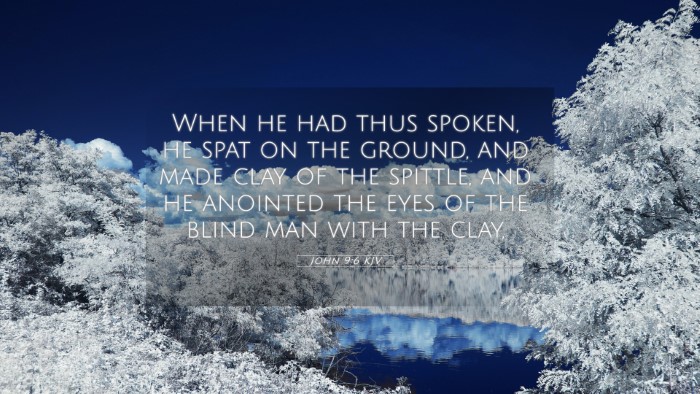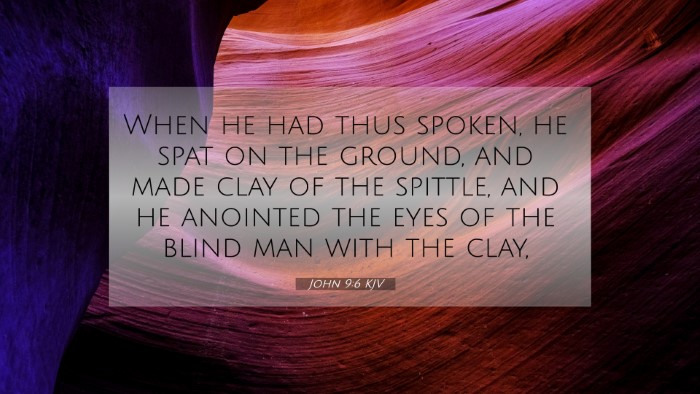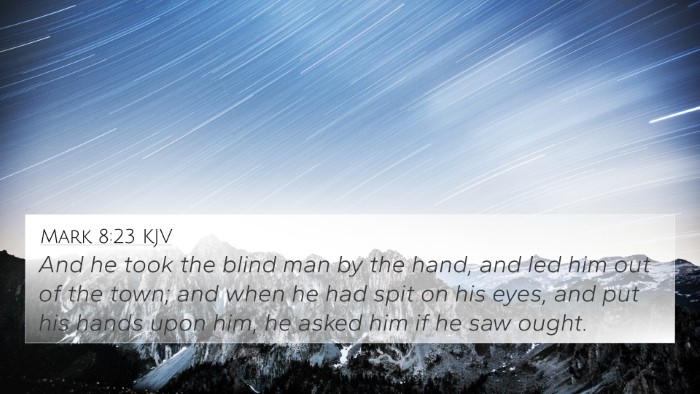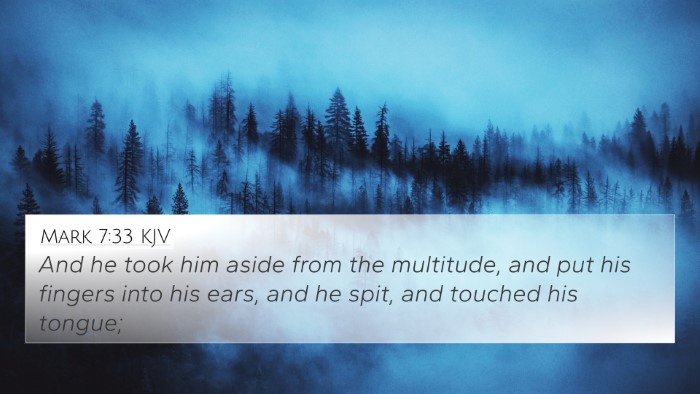Understanding John 9:6
In John 9:6, we read, "When he had thus spoken, he spat on the ground, and made clay of the spittle, and he anointed the eyes of the blind man with the clay." This remarkable event unfolds a profound message about the healing power of Jesus, the significance of faith, and the interplay between physical and spiritual vision.
Summary of Key Insights
The act of Jesus using clay made from spittle is laden with theological significance. Commentators such as Matthew Henry, Albert Barnes, and Adam Clarke offer profound insights into this moment.
- Context of the Miracle: Jesus encounters a man who had been blind from birth (John 9:1). This serves as a backdrop for exploring themes of sin, belief, and divine intervention.
- Symbolism of Clay: The clay symbolizes the Creator's power to shape and form, reminiscent of God's creation of man from dust (Genesis 2:7). This act by Jesus reiterates His divine authority.
- Act of Healing: By anointing the man's eyes with clay, Jesus not only performs a miracle but also emphasizes the necessity of human participation in the healing. The man is instructed to wash in the Pool of Siloam (John 9:7) — a theme of obedience plays a vital role in receiving healing.
- Connection with Spiritual Blindness: This miracle serves as a metaphor for spiritual blindness and sight. The physical healing foreshadows the spiritual enlightenment that Jesus provides to all who believe in Him.
- Reaction of the Community: Following his healing, the former blind man experiences disbelief and questioning from those in his community, highlighting human skepticism regarding divine works.
Cross-References to John 9:6
John 9:6 can be understood more deeply when viewed in light of several other scriptures:
- Genesis 2:7: "And the LORD God formed man of the dust of the ground..." - This verse parallels the use of clay representing God's creative power.
- Isaiah 61:1: "The Spirit of the Lord GOD is upon me; because the LORD hath anointed me to preach good tidings unto the meek..." - Echoes the theme of anointing and divine mission.
- Mark 8:23: "And he took the blind man by the hand, and led him out of the town; and when he had spit on his eyes..." - Another example of Jesus healing a blind person, highlighting His methods and compassion.
- Matthew 11:5: "The blind receive their sight..." - A summary of Jesus' miraculous works that emphasizes His role as the Messiah.
- John 8:12: "I am the light of the world: he that followeth me shall not walk in darkness..." - This statement by Jesus connects spiritual sight with His identity.
- Psalm 146:8: "The LORD openeth the eyes of the blind..." - A promise of God’s intervention in the lives of those who are blind.
- Romans 10:17: "So then faith cometh by hearing, and hearing by the word of God." - Faith is vital for understanding and accepting the works of Jesus.
Exploring Thematic Connections
This verse also connects deeply with various themes found throughout the Bible:
- The Healing Power of Jesus: The miracles performed by Jesus continually illustrate His authority over physical ailments and spiritual conditions.
- Faith and Obedience: The blind man's response to Jesus’ commands emphasizes that faith requires action and obedience.
- Spiritual Vision vs. Physical Vision: The dichotomy between physical blindness and spiritual receptivity serves as a recurring theme throughout John’s Gospel.
Importance of Cross-Referencing
Cross-referencing biblical texts enriches our understanding of scripture. Tools for Bible cross-referencing, like a Bible concordance or a Bible cross-reference guide, can greatly enhance the study process.
How to Use Bible Cross-References
Utilizing cross-references helps in:
- Identifying connections between key themes and events.
- Understanding the broader context of certain passages.
- Enhancing sermon preparation by providing additional biblical support.
- Drawing parallels between the narratives of different biblical authors.
Whether you are engaging in personal study, preparing for teachings, or seeking spiritual growth, leveraging cross-reference techniques can deepen your appreciation for biblical truth.
Conclusion
John 9:6 serves as more than a narrative of physical healing; it encapsulates pivotal themes of creation, faith, and spiritual awakening. By recognizing the interconnectedness of scripture through cross-referencing and comparative analysis, believers can better understand the rich tapestry of God's word. The insights from seasoned commentators like Matthew Henry, Albert Barnes, and Adam Clarke further enhance our comprehension, reminding us of the transformative power of Jesus in the lives of individuals and the broader human experience.
As you delve deeper into the scripture and its meanings, consider how various verses interlink and what God might be revealing through these connections.





